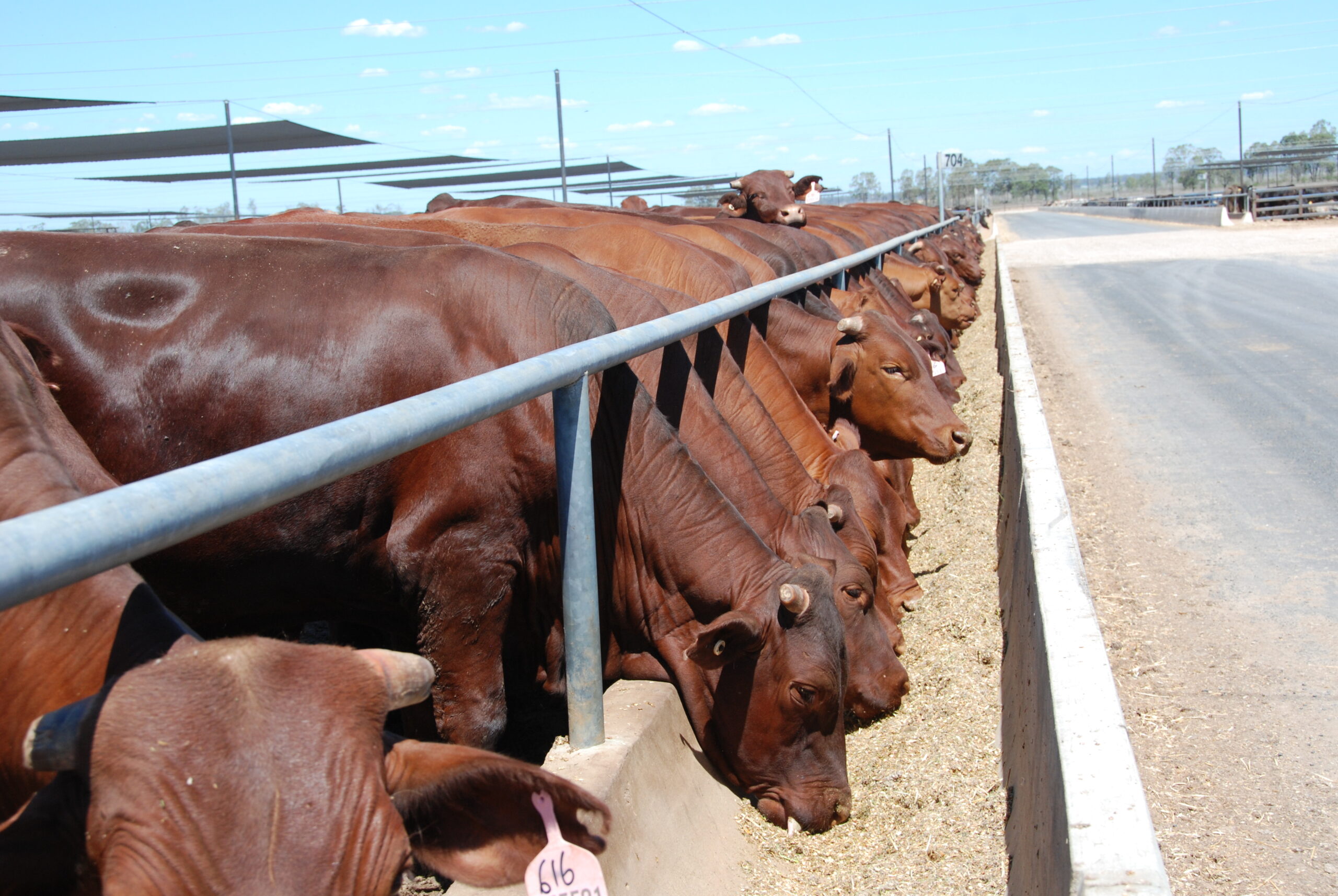Feed intake and liveweight gain
The key variables affecting the profitability of feedlots are:
- store cattle purchase price
- finished cattle sale price
- cost of feed consumed
- feed intake and liveweight gain.
This fact sheet deals with feed intake and liveweight gain.
Feed intake
Commodities used in feedlot rations vary considerably in dry matter content (DM).
For example, hay and grain are approximately 90% DM, molasses is 75% DM and silage 40% DM.
A basic guide for estimating consumption of feedlot animals is to calculate 2.7% to 3.0% of their liveweight (in kilograms) in dry matter.
Example calculation
If we were to estimate the intake of a 450 kg animal, consuming a grain-based diet of 90% DM, we would have an estimated intake of fresh feed of 13.5-15 kg/head/day.
It is calculated as:
= 450 kg animal x 2.7% of body weight intake
= 12.15 kg, however, remembering that grain is 90% DM, we would then
= 12.15 / 90%
= 13.5 kg fresh feed (also known as, ‘as fed’)
If we were to increase the estimate to 3% of body weight, it would be calculated as:
= 450 kg animal x 3% of body weight intake
=13.5 kg, however, remembering that grain is 90% DM, we would then
= 13.5 / 90%
= 15 kg fresh feed (also known as, ‘as fed’)
However if we were to extrapolate the estimate of feed required to have on hand for heavy steers destined for the Japanese short-fed market, that have an entry weight of approximately 450 kg and a finished weight of 600 kg, an average weight during their time on feed would be 525 kg.
Example average weight calculation: = (450 + 600)/2
= 525 kg animal x 3% body weight
= 15.75 / 90%
= 17.5 kg fresh feed
Total fresh feed consumption for 100 days = 17.5 kg x 100 days
= 1750 kg per head.
The caveats to estimating intake
Although these figures are good for providing estimates of feed required, the reality is, there are a number of factors that influence daily intake of lot-fed cattle. These include, liveweight (their required maintenance energy requirements), body condition, energy concentration of the ration, health status, and ration palatability.
Young animals and animals of lighter body condition may eat greater than 3% of their body weight on a dry matter basis as they have a higher maintenance energy requirement. Whereas older animals and animals in better body condition, will have a lower dry matter intake, closer to 2.7%.
The energy of a ration is measured in megajoules (MJ) of metabolisable energy (ME) per kilogram of feed on a dry matter basis.
Metabolisable energy content of a ration can also affect feed intake, with extremes in ME content reducing consumption relative to the optimum ME content of the ration.
Palatability of the ration also effects consumption. Very low DM content diets (less than 40%) can result in reduced dry matter consumption.
Feedlot managers usually find that cattle in backward store condition (drought affected) need to be held in the feedlot for extended periods to meet market requirements. However, these cattle often consume well over 3% of their liveweight and have exceptional liveweight gain. These fast gainers invariably have high feed conversion efficiency (liveweight gain: feed intake).
Liveweight gain
Variation in intake can have a large effect on liveweight gain and therefore must be minimised.
In addition to feed intake, many factors can affect liveweight gain. The most important of these include age, sex, genetic merit, breed, body condition, health status, diet composition, diet nutrient content, presence of a growth promotant, and previous nutritional history.
Noticeable variation occurs between animals in relation to an optimum finish point.
Older animals will achieve optimum finish faster than younger animals, as these animals are nearing the end of their growth period and will partition most of their nutrient intake into finishing. Younger animals, on the other hand, will partition a proportion of their intake towards skeletal and muscle development. Because heifers mature earlier than steers, they will normally finish sooner and may require closer supervision to avoid excess fat.
As a rule, European breeds grow faster than British or Zebu breeds and tend to be leaner, but there can be as much variation within a breed as between breeds. As cattle finish, their rate of liveweight gain diminishes slightly. Health problems, whether it be acidosis, respiratory disease or from other causes, can also be reflected in poor liveweight gain of individual animals. A nutrient imbalance, such as a deficiency of energy, protein, minerals or vitamins, can also cause a reduction in liveweight gain.
Growth promotants and rumen modifiers have proven to enhance liveweight gain. Any restriction in feed or water intake, causes a reduction in liveweight gain.
The following table is a guide to likely daily liveweight gains for some lot-feeding systems.
| Market specification * | Average gain (kg / head / day) | Range (kg / head / day) |
|---|---|---|
| Domestic trade - steers | 1.4 | 1.1 to 1.7 |
| Domestic trade - heifers | 1.3 | 1 to 1.6 |
| Korea | 1.5 | 1.2 to 1.8 |
| Japan - short fed | 1.5 | 1.2 to 1.8 |
| Japan - long fed | 1.3 | 1 to 1.6 |
*It is important to know the market specifications for finished cattle to determine the specifications of the store cattle entering the feedlot.
Consistent weighing procedures
The normal procedure with lot-fed cattle, if measuring for liveweight gain, is to weigh before the morning feed. Doing so, removes any confounding influence of any gut fill the animals had at initial induction. Standard weighing procedures need to be adopted when determining liveweight gain.
Written by Sarah-Jane Forster, formerly Queensland Government.
If you would like more information, contact the Department of Agriculture and Fisheries Customer Service Centre on 13 25 23, or email info@daf.qld.gov.au.